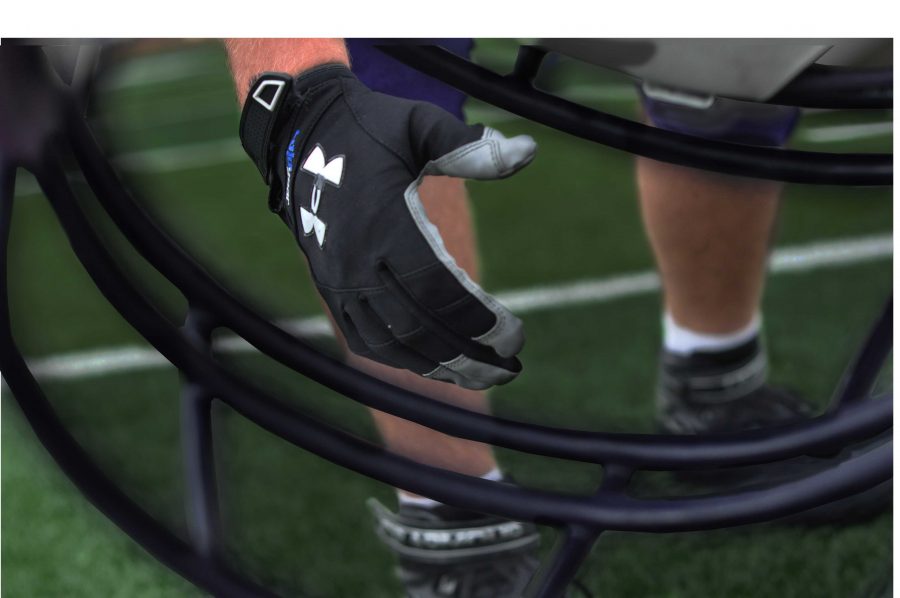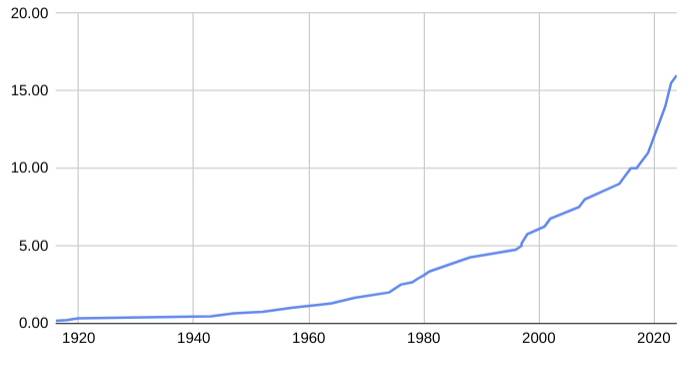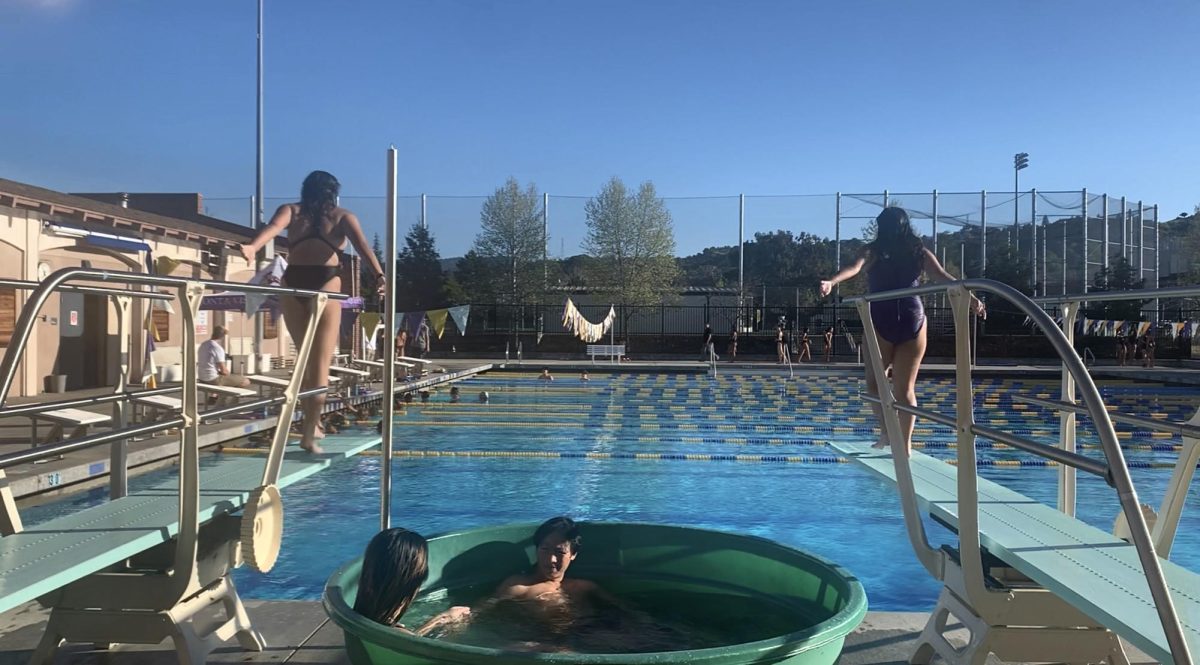When I walk into the office of MVHS athletic trainer Marie Gishifu at 4 p.m. on Sept. 26, there are three football players there already, each with a different injury. Gishifu is wrapping the ankle of junior Saxon Day.
“What are you interviewing Marie about?” Day asks me, blood oozing from underneath the ice pack.
“Concussions,” I reply. “Do you know anyone who’s had one?”
Day shrugs. “Pretty much everyone. Chris Flores, Kyle Barry, Amol Pande, Brian Kearns.”
Senior Michael Ching, stretching out a pulled muscle, looks up. “T,” he says.
“Oh yeah, Tijani Karaborni. And Robert Foreman. He’s had four.”
I raise my eyebrows. “Four concussions?”
All three of them — Day, Ching and sophomore Wells Chang — laugh.
“Yeah, something like that,” Day says. “Foreman’s out for the season.”
I later spoke with Foreman, a senior on the varsity football team. And he has, in fact, had four concussions.
A growing problem
The last few years have seen a rise in both the severity and frequency of sports injuries at the professional and high school levels. With recent high-profile injuries like the Sept. 23 helmet-to-helmet collision between Oakland Raiders wide receiver Darrius Heyward-Bey and Pittsburgh Steelers safety Ryan Mundy — Heyward-Bey attempted to catch a ball in the endzone but was knocked out by Mundy — concerns about concussions in the NFL have increased significantly. The same is true for high school-level athletics; according to the Centers for Disease Prevention, concussions among youth have risen 60 percent in the last nine years. With studies indicating so strong a link between concussions and long-term brain damage, immediate medical attention is critical to prevent further injury.
But now, it is no longer about concussions alone. Even seemingly minor injuries like muscle strains can easily become aggravated if put under the strain of sports. The stress of repeated physical actions, such as running, can cause long-term injuries.
Out of 26 surveyed football players on both the varsity and JV football teams, 54 percent said they had played with a serious injury at least once before. And the injuries they reported — fractures, broken bones, sprains — are certainly not minor ones.
The mechanics of a concussion
The first football-related concussion Foreman suffered was during an after-school practice his freshman year. Foreman was playing defensive back when one of his teammates tackled him, taking him to the ground — hard.
“I fell back, and basically everything goes black and you’re stuck in a daze,” Foreman said. “You fall and you feel like you weigh a thousand pounds and it’s hard to get up, and once you do, you just don’t really know what’s going on.”
When a player goes down, the effects of the tackle are not always immediately visible. But according to a study by the University of Michigan, the sheer force of a full-on tackle, even in a high school game, often exceeds 40 g, or more than ten times the g-force of the average roller coaster; concussions usually happen somewhere around 90 to 100 g. Weighing in at an average of three pounds, the brain is suspended in cerebrospinal fluid but cannot withstand a sustained force of over 10 g, according to studies by the Mayo Clinic. Compound that excessive force with the frequency of contact — the football team usually plays one game per week and practices on the other four school days — and minor symptoms quickly escalate, becoming hazardous to the health of the players.
The impact rattles the soft, still-developing brain when hard contact is made. While the brain is encased in a protective skull, such strong force causes damage as the brain to be compressed against the inner backside of the skull. The player stops moving once he hits the ground; with nothing to stop the brain, however, it continues in motion. And if the impact is great enough, the brain rebounds one more time, striking the inner front of the skull and further damaging both the brain and the skull’s lining.
“They get headaches, nausea, coordination problems, balance is off … it gets to a point that [concussions are] just scary,” Gishifu said.
Repeated concussions have been associated with neurological damage, including amnesia, dementia and later onset diseases, such as Parkinson’s.
Keeping up with everyone else
Senior Nathan Facciolla appears in the doorway, blood dripping from a cut on his finger, a grin on his face.
“Can you fix this?” he asks Gishifu.
Gishifu grabs a roll of gauze from the cabinet and swiftly disinfects and wraps the finger. In less than two minutes, Facciolla is gone, back on the field to rejoin the team’s practice.
Two more players later come to see Gishifu, one with a bloody gash on his leg, the other complaining of shoulder mobility problems. They are both attended to; they both return to practice within minutes.
According to Gishifu, the players that she examines for injuries are frequently impatient to return to the field, even if they have not completed the entire healing process.
“They don’t want to sit out; they want to keep playing. So either they don’t tell me [about the symptoms] or they lie,” Gishifu said. “But it’s understandable … that they’re really upset.”
But as Foreman says, sitting out to heal and receive treatment often makes it difficult to return to the sport at the same level of performance. Several weeks spent recuperating could easily mean losing a starting role, especially in football, which currently carries 39 players on its varsity team.
“[Coaches and teammates] want to make sure that you heal,” Foreman said. “[But] you feel pressured … because you feel like you lose your spot.”
In the survey, “potential loss of a starting role on the team” was the top factor, with 78 percent of respondents reporting that it affects their decision of whether or not to play through an injury. And in a close second came “appearance of being weak/not as tough” with 61 percent of the respondents relating to this. Another common response was feeling an obligation to the team, or as one respondent said, “not wanting to let the team down.” In addition, 69 percent of the players felt that athletes are either “highly pressured” or “somewhat pressured” to play through injuries.
Playing through a serious injury is particularly dangerous for potential concussions. Though the symptoms may fade in a matter of days, concussions — even minor ones — are still considered traumatic injuries to the brain. A recent concussion leaves the brain vulnerable to future injury; any contact can easily provoke a resurgence in symptoms, leaving the brain in a worsened condition.
Pressure sometimes surrounds players as well, Gishifu says, making them feel unable to take off adequate time from athletics to fully recover.
“High school kids have the ego stuff going. I was a high school kid before, so I understand, but now I feel like I’m responsible for them,” Gishifu said. “They need to understand the nature of the injury … It only gets worse if they just shut it off.”
Long-term injuries
Many players push through the pain of injuries to return to athletics, but lingering injuries are extremely vulnerable to further damage. For Foreman, this experience came with his fourth concussion.
“We were doing hitting drills … we went for one last hit .. and everything just goes black, and I start stumbling around, and I can’t walk in a straight line,” Foreman said. “So my coach just told me to go sit down and talk to the trainer.”
But what Foreman had not expected was that his most recent concussion, suffered just this preseason, would spell the end of his high school football career.
“I went to the doctor and she told me I’ve had too many concussions,” Foreman said. “I thought I was going to take, like, a week off and come back. And then I made it to two weeks, but then my doctor called me on the phone and said she advised me not to play anymore … I was stunned … and it was just, like, the worst feeling ever.”
Foreman, however, says that he was fortunate to receive support from those around him, allowing him to put his health as the first priority.
“[My parents] were definitely worried … and my coach told me how sorry he was [that] this happened,” Foreman said. “Three or four concussions in the long run isn’t worth risking it in high school.”
Difficult to protect against
The past decade has seen improvements in protective measures and equipment, especially in football. Concerns about the frequency and severity of collisions were raised — the rate of collisions that occur during kickoffs is disproportionately higher than those of other plays. High speeds and adrenaline rushes are also incurred during kickoffs and kickoff returns, considered some of the most exciting plays of the game. Combine this with the fact that the average NFL player weighs 248 pounds, according to ESPN, and plays like these are dangerous situations waiting to happen. As a result, earlier this year, the NCAA approved a change effective in the fall of 2012. Instead of beginning the game with a kickoff at the 30-yard line, teams will kick off at the 35-yard line and the maximum running start for these kickoffs is now limited to five yards in an attempt to make the game safer.
Equipment has also evolved with research; after additional studies on the dangers of concussions, a polyurethane cap, which Gishifu now asks post-concussion players to wear, was developed to help prevent recurrent concussions. Helmets have also undergone changes to absorb more shock and offer more protection in the case of head-on collisions. Though direct, helmet-to-helmet contact violates official rules, tackles like these still occur and pose a threat to the health of players; in the recent NFL incident, for example, Heyward-Bey immediately lost consciousness and was diagnosed with a concussion and neck strain, which was considered a miracle given the force and speed of the collision with Mundy.
Though helmets are generally effective at lessening the number of external injuries, their hard nature — necessary to protect against lacerations and other blunt force injuries — make it difficult to prevent concussions. The stiff plastic of the helmet does not absorb shock as well as something more supple, causing vibrations to wrack the brain. The football team, however, primarily uses the Riddell Revolution Speed helmet, which received a full five-star concussion prevention rating in a study by Virginia Tech. Though such helmets are costly, retailing at $264.99 each, they are seen as investments for players’ health and safety.
Breaking the cycle
Players come into the training room with concussion symptoms about once a month throughout the season, but when football practices first start in the summertime, Gishifu says it is not uncommon to test one or two players each week; getting back into the routine of football often mean more injuries. And Gishifu’s office is constantly filled with athletes, whether from football or other sports, with a variety of many other injuries as well.
In an attempt to reduce the risk of long-term damage to players, the MVHS athletic program has implemented was to recognize — and monitor — potential concussions as well as other serious injuries, helping improve the safety of a notoriously physical and dangerous sport. At the beginning of the season, each football player is required to undergo a test administered by Gishifu. The results of the test, which includes examining coordination, memory recall, immediate recall, delayed recall, orientation and alertness, are recorded and stored. And when a player takes a particularly hard hit or begins to show signs of a concussion, he takes the test again with Gishifu, who cross-checks the new results with the original ones.
“After [the test], they’ll be sent to the doctor,” Gishifu said. “There’s a California law with concussions. [Players] are required to see the doctor for a second evaluation and a follow-up.”
Even after a formal doctor’s visit, the football program requires a written note from a medical professional as well as an additional test by Gishifu before the player can return to football. If concerns remain, Gishifu can order additional recovery time, which can be anywhere from one to two weeks.
“Every concussion is different,” Gishifu said. “You can’t really range it from mild to severe. That’s the thing.”
Looking up
According to Gishifu, the safety changes that the football program has undergone has helped athletes and parents become more aware of serious injuries, allowing players to make better decisions regarding rest time and medical treatment following a major injury.
“[Football players] are in a contact sport … they do know the risks, they know the level of injuries that they can sustain, and they’re more than aware of that,” Gishifu said. “As much as we have improved over the years, there’s always room for improvement.”
And though Foreman’s journey has been difficult, his experiences — and the support he received from the football community even after his season-ending injury — have helped him keep a positive perspective. He harbors no resentment toward the teammates who tackled him, saying those instances were simply accidents, and he has not ruled out playing football in the future either.
“We joke around and stuff, and I know that they want me to play,” Foreman said. “I can’t be out there, but I try to help out as much as I can.”




















